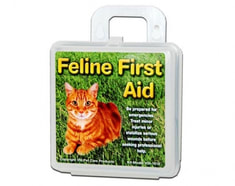Dr Jo Blogs
Expert Cat Care Advice
Common Emergencies in Cats
Dr Jo Lewis MRCVS | 10 Jul 2021 | 5 min read
Share:
Here are a few common emergency situations that occur in cats and some general advice on how to deal with them. Remember this information is not designed to replace your veterinary surgeon! Always seek veterinary advice if you are concerned about your cat.
Bleeding
Spurting blood or prolonged bleeding is an emergency situation. Much of the time, heavy bleeding can be stopped in short amount of time with a pressure bandage. One bleeding instance where it seems like but rarely is an emergency is when you “quick” a nail while trimming claws. Quicked nails bleed for a long time and it can seem like a lot, but most times not a lot of total blood loss occurs.
Keep the cat quiet and calm. Put on a tight bandage. Improvise with strips of towel or clothing if necessary. If blood is seeping through, apply another tight layer. Only use a tourniquet as a last resort. If you cannot put on a bandage, press a pad firmly onto the wound and hold it in place. Go to the vet straight away.
If you have bandaging materials, layer these as follows. Firstly, place a nonstick dressing on the wound and cover with swabs or a cotton bandage. Then place a layer of cotton wool over this and cover again with cotton bandage. Secure this top layer of bandage to the hair with surgical tape, and cover all of it with adhesive bandage or tape. Do not stick Elastoplast to the hair and never leave a bandage on for more than 24 hours.
Spurting blood or prolonged bleeding is an emergency situation. Much of the time, heavy bleeding can be stopped in short amount of time with a pressure bandage. One bleeding instance where it seems like but rarely is an emergency is when you “quick” a nail while trimming claws. Quicked nails bleed for a long time and it can seem like a lot, but most times not a lot of total blood loss occurs.
Keep the cat quiet and calm. Put on a tight bandage. Improvise with strips of towel or clothing if necessary. If blood is seeping through, apply another tight layer. Only use a tourniquet as a last resort. If you cannot put on a bandage, press a pad firmly onto the wound and hold it in place. Go to the vet straight away.
If you have bandaging materials, layer these as follows. Firstly, place a nonstick dressing on the wound and cover with swabs or a cotton bandage. Then place a layer of cotton wool over this and cover again with cotton bandage. Secure this top layer of bandage to the hair with surgical tape, and cover all of it with adhesive bandage or tape. Do not stick Elastoplast to the hair and never leave a bandage on for more than 24 hours.
Lacerations
The majority of lacerations, while they may well need veterinary attention as soon as possible, or not emergencies. Lacerations that are emergencies are those that are deep enough to hit bone, puncture wounds, and lacerations to sensitive areas like the eye or the genitalia. Many of these lacerations create environments for infections that are hard to treat; the sooner the laceration is treated and antibiotics begun, the better chance of avoiding serious infection. And lacerations that require suturing have “golden window” of a few hours. Outside of this window, suturing is not recommended because infection may have set in and the suturing will simply enclose it or perhaps the wound edges have been traumatized enough to make suturing impossible.
Burns and scalds
Run cold water over these for at least five minutes then contact your vet. Do not apply ointments or creams, although you can cover the wound with a saline-soaked gauze pad while awaiting treatment. Remember to keep the patient warm.
The majority of lacerations, while they may well need veterinary attention as soon as possible, or not emergencies. Lacerations that are emergencies are those that are deep enough to hit bone, puncture wounds, and lacerations to sensitive areas like the eye or the genitalia. Many of these lacerations create environments for infections that are hard to treat; the sooner the laceration is treated and antibiotics begun, the better chance of avoiding serious infection. And lacerations that require suturing have “golden window” of a few hours. Outside of this window, suturing is not recommended because infection may have set in and the suturing will simply enclose it or perhaps the wound edges have been traumatized enough to make suturing impossible.
Burns and scalds
Run cold water over these for at least five minutes then contact your vet. Do not apply ointments or creams, although you can cover the wound with a saline-soaked gauze pad while awaiting treatment. Remember to keep the patient warm.
Traumatic Injuries (eg road traffic accidents)
If you think your cat has been hit by a car take them to a vet as soon as possible. Other sorts of trauma include being shot, falls from high places (despite common mythology, cats do not always land on their feet and even then can get seriously hurt in a fall), dog attacks, accidents through playing with children—whether you are sure there is a broken bone or not, always treat trauma as an emergency.
Internal bleeding can occur without showing any outward signs initially and therefore it is important that a vet sees him. If you suspect your cat has a broken leg or head injury you should carefully slide them onto a towel or blanket and keep them warm. Place him/her in a box for transportation to the surgery. Since cats are expert escapologists (particularly when sick/stressed) please remember to use a secure box!
Internal bleeding can occur without showing any outward signs initially and therefore it is important that a vet sees him. If you suspect your cat has a broken leg or head injury you should carefully slide them onto a towel or blanket and keep them warm. Place him/her in a box for transportation to the surgery. Since cats are expert escapologists (particularly when sick/stressed) please remember to use a secure box!
Broken bones
Deal with any serious bleeding but do not apply a splint – it is painful, and can cause the bone to break through the skin. Confine the patient to a well padded carrier for transportation to the vet.
Tail injuries
Contact a vet if your cat’s tail is limp, has been trapped in a door, or pulled hard. Such injuries can cause serious bladder problems and need urgent assessment.
Eye injuries
Do not allow rubbing of a sore eye with the paws – use an Elizabethan collar. Contact a vet immediately if there has been trauma, if your cat has a closed or discharging eye, or for any sudden eye problem. If chemicals have entered the cat’s eye, flush out with water repeatedly for at least 15-20 minutes (preferably from an eye bottle) and call a vet.
Electrocution
If a high voltage, non-domestic (for example, power lines) supply is involved, do not approach. Call the police. In the home, turn off power first. If this is impossible, you may be able to use a dry non-metallic item, like a broom handle, to push a cat away from the power source. If breathing has stopped, give resuscitation. Call the vet immediately.
Seizures
Most seizures are not emergencies but it's always best to contact your vet by phone. They will who triage your call and decide whether your cat needs to be seen immediately or whether you should monitor and book a consultation if they happen again. The exception to this is a seizure lasting more than two minutes, if your cat seems unwell at the time or afterwards or if the seizures keep happening repeatedly.
Deal with any serious bleeding but do not apply a splint – it is painful, and can cause the bone to break through the skin. Confine the patient to a well padded carrier for transportation to the vet.
Tail injuries
Contact a vet if your cat’s tail is limp, has been trapped in a door, or pulled hard. Such injuries can cause serious bladder problems and need urgent assessment.
Eye injuries
Do not allow rubbing of a sore eye with the paws – use an Elizabethan collar. Contact a vet immediately if there has been trauma, if your cat has a closed or discharging eye, or for any sudden eye problem. If chemicals have entered the cat’s eye, flush out with water repeatedly for at least 15-20 minutes (preferably from an eye bottle) and call a vet.
Electrocution
If a high voltage, non-domestic (for example, power lines) supply is involved, do not approach. Call the police. In the home, turn off power first. If this is impossible, you may be able to use a dry non-metallic item, like a broom handle, to push a cat away from the power source. If breathing has stopped, give resuscitation. Call the vet immediately.
Seizures
Most seizures are not emergencies but it's always best to contact your vet by phone. They will who triage your call and decide whether your cat needs to be seen immediately or whether you should monitor and book a consultation if they happen again. The exception to this is a seizure lasting more than two minutes, if your cat seems unwell at the time or afterwards or if the seizures keep happening repeatedly.
Blockage of the Urinary Tract
If your cat starts straining frequently in the litter tray (or anywhere else!) then they may be suffering from cystitis (inflammation and pain in the bladder) or bladder stones. Commonly owners mistake these signs as "constipation" but that is in fact much less likely in cats. More common is that cats develop small stones or spasms that can block the flow of urine and prevent the bladder from emptying. This becomes very painful and is life-threatening. Please contact a vet immediately if these signs occur.
Heatstroke
Heatstroke is rare but can happen if a cat has been trapped somewhere such as a shed, greenhouse or conservatory on a hot day. Affected animals are weak, panting, dribbling and distressed. Put the cat somewhere cool, preferably in a draught. Wet their coat with tepid water (not cold water as this contracts the blood vessels in the skin and slows heat loss) and phone the vet. You may offer the cat a small amount of water.
Drowning
Never put yourself at risk attempting to rescue a drowning cat. Wipe away material from the mouth and nose and hold the cat upside down by the hind legs until any water has drained out. Give resuscitation if breathing has stopped. Even if your pet seems to recover, always see the vet, as complications afterwards are common.
Breathing Difficulties
Please contact your vet as soon as possible if you notice any changes in breathing patterns or persistent breathlessness or open-mouthed panting lasting more than a few minutes.
Aortic Thrombo-Embolism
This is a very serious condition in which a blood clot blocks a major blood vessel supplying the back legs. Signs include:
Heatstroke is rare but can happen if a cat has been trapped somewhere such as a shed, greenhouse or conservatory on a hot day. Affected animals are weak, panting, dribbling and distressed. Put the cat somewhere cool, preferably in a draught. Wet their coat with tepid water (not cold water as this contracts the blood vessels in the skin and slows heat loss) and phone the vet. You may offer the cat a small amount of water.
Drowning
Never put yourself at risk attempting to rescue a drowning cat. Wipe away material from the mouth and nose and hold the cat upside down by the hind legs until any water has drained out. Give resuscitation if breathing has stopped. Even if your pet seems to recover, always see the vet, as complications afterwards are common.
Breathing Difficulties
Please contact your vet as soon as possible if you notice any changes in breathing patterns or persistent breathlessness or open-mouthed panting lasting more than a few minutes.
Aortic Thrombo-Embolism
This is a very serious condition in which a blood clot blocks a major blood vessel supplying the back legs. Signs include:
- Sudden loss of the ability to use one or both back legs.
- Crying out and appearing to be in pain.
- This condition can be easily confused with a road accident. Please contact your vet immediately and prepare to take your cat in.
Diabetic Coma
Cats with diabetes can experience extremes of blood glucose levels (high or low glucose). Low glucose can cause a diabetic coma which is a serious emergency. Anytime an animal is unresponsive is an emergency situation; be sure to tell the attending emergency vet bout your cat’s diabetes history.
High Temperature
Cats sometimes develop a very high temperature, often in response to an infection. Affected cats may be dull or sleepy, and reluctant to eat or drink. Cats can have a fever without being hot to the touch.
Cats with diabetes can experience extremes of blood glucose levels (high or low glucose). Low glucose can cause a diabetic coma which is a serious emergency. Anytime an animal is unresponsive is an emergency situation; be sure to tell the attending emergency vet bout your cat’s diabetes history.
High Temperature
Cats sometimes develop a very high temperature, often in response to an infection. Affected cats may be dull or sleepy, and reluctant to eat or drink. Cats can have a fever without being hot to the touch.
Toxic/Poisonous Reactions
A toxic reaction (severe vomiting, unresponsiveness) could be from snakebite, ingesting poison, ingesting a toxic plant, and many other possibilities. Whether you know what the animal is reacting to or not, this is an emergency!
A toxic reaction (severe vomiting, unresponsiveness) could be from snakebite, ingesting poison, ingesting a toxic plant, and many other possibilities. Whether you know what the animal is reacting to or not, this is an emergency!
Common Poisons
- Paracetamol and ibuprofen are poisonous to cats and should never be given. Aspirin should only be administered on instruction by a veterinary surgeon.
- Some plants and flowers, and all parts of the lily plant, are highly poisonous to cats. If you think your cat may have ingested these please contact your vet immediately.
- Antifreeze is highly toxic to cats.
NB: This is not intended as a complete list of cat poisons - if in doubt contact the emergency centre.
Coat contamination
If a substance such as paint or tar has got onto your cat’s coat or paws, prevent your cat licking it, as the substance may be toxic. Use an Elizabethan collar (obtainable from vets) if you have one.
You may be able to clip off the small areas of affected hair, but never use turpentine or paint remover on your cat. Contact the vet, as bathing may be necessary. Sedatives may be required to do this thoroughly.
If a substance such as paint or tar has got onto your cat’s coat or paws, prevent your cat licking it, as the substance may be toxic. Use an Elizabethan collar (obtainable from vets) if you have one.
You may be able to clip off the small areas of affected hair, but never use turpentine or paint remover on your cat. Contact the vet, as bathing may be necessary. Sedatives may be required to do this thoroughly.
Allergic reactions (eg insect stings)
Like us, on rare occasions cats can have allergic reactions to insect stings, drugs including vaccination. The most severe reaction is anaphylaxis, a sudden, severe allergic response.
Signs usually include sudden onset of vomiting, diarrhea, staggering, a rapid drop in blood pressure, swelling of the airways (and inability to breathe), seizures, collapse or death. This reaction is life-threatening for your cat and warrants the most urgent veterinary attention.
To download a guide to first aid of insect stings click here
Like us, on rare occasions cats can have allergic reactions to insect stings, drugs including vaccination. The most severe reaction is anaphylaxis, a sudden, severe allergic response.
Signs usually include sudden onset of vomiting, diarrhea, staggering, a rapid drop in blood pressure, swelling of the airways (and inability to breathe), seizures, collapse or death. This reaction is life-threatening for your cat and warrants the most urgent veterinary attention.
To download a guide to first aid of insect stings click here
Infected Wounds and Bite Abscesses
These often appear as a swelling around the face, head or paws. They may apear as painful swellings or burst and smelly green-brown/bloody fluid may drain out. If your cat will tolerate it, you may assist drainage of these wounds by regularly cleaning the area with warm slightly salted water and cotton wool. Cats with infected wounds will frequently require antibiotics and you should seek advice sooner rather than later to avoid sepsis.
NEVER ever use household human antiseptics (eg Dettol), disinfectants or wound creams (eg Savlon) on cats as they cause further damage and are often toxic if licked.
These often appear as a swelling around the face, head or paws. They may apear as painful swellings or burst and smelly green-brown/bloody fluid may drain out. If your cat will tolerate it, you may assist drainage of these wounds by regularly cleaning the area with warm slightly salted water and cotton wool. Cats with infected wounds will frequently require antibiotics and you should seek advice sooner rather than later to avoid sepsis.
NEVER ever use household human antiseptics (eg Dettol), disinfectants or wound creams (eg Savlon) on cats as they cause further damage and are often toxic if licked.
Pregnancy, Birthing and Post-birthing Issues
Birthing issues that should prompt you to seek immediate veterinary care:
- If your cat is having active contractions and has not passed a kitten within 30 minutes
- If you see part of the foetus or placenta protruding from your cat’s vulva and she does not pass the kitten very quickly (within 2-3 strains over several minutes)
- It’s not abnormal for a cat to rest between having kittens but if more than 2 hours passes between kittens consult your vet.
- If your cat has not delivered all kittens within 36 hours.
- If your cat is crying and biting at their genitals
- If you are worried – trust your instinct if you are concerned as it is better to be safe than sorry.
Within a few days of your cat giving birth you should arrange to have your cat and the new kitten(s) checked over by a vet.
Seek immediate veterinary care in the meantime if:
Your cat appears to be:
Your cat appears to be:
- Unwell - this may be difficult to detect but things like changes in their usual behaviour or routines (eg hiding away or interacting less with you), looking subdued/depressed/lethargic or in shock or sometimes the opposite and seeming agitated/distressed/unsettled or uncomfy.
- Not eating well or going to the toilet normally
- Vomiting or passing diarrhoea
- Excessively thirsty
- Discharging fresh blood from the vulva
- Discharging brownish discharge for more than a couple of days after passing the kittens.
- Discharge from the vulva at any time that is green/grey colour or is foul smelling is not normal (likely a uterine infection).
- Bulging or swelling around the vulva
- Disinterested in feeding, cleaning and nurturing the kittens
- Showing red, hot, hard, swollen teats/breasts (one of more may be affected). In its advanced stages the skin can also look dark red to purple in colour. This is a sign of mastitis.
- Clumsy, weak, tremoring or seizuring (fitting). This can indicate a life-threatening depletion in calcium levels commonly called “milk fever” or “lactation tetany”. It can happen at any time, is more common with big litters and generally when the kittens start to grow and place more demands on her milk supply (usually a few weeks after birth).
The newborn kittens ....
- Should be feeding within two hours of birth and need to feed every 2 hours thereafter. In the first 24 hours of life they need to get plenty of the antibody-rich first milk (colostrum) which protects them against disease. Kittens are like babies and can dehydrate and die rapidly if they are not feeding this regularly.
- Cannot regulate their own body temperature very well so they are particularly susceptible to becoming weak and cold if you are not keeping a close eye on them.
First time or very tired mother cats often neglect their kittens so don't assume they are able to cope. You may need to intervene with heat pads, hot water bottles and hand feeding with special powdered cat formula milk.
Never feed kittens cows milk, tinned milk (condensed/evaporated), cat milk designed for older kittens/adult cats or human infant formula milk as this will only upset their fragile new tummies, leading to diarrhoea, further dehydration and death.
Monitor and weigh kittens daily using digital kitchen scales (very cheap to buy online).
Always remember that yes, animals have been successfully reproducing in the wild since the beginning of time, but many will suffer life threatening complications and suffer slow painful deaths too. Birthing complications are not unique to pure-bred/pedigree cats and many moggies can experience problems too.
Your duty as a responsible cat owner is to first and foremost NEUTER your cat but if in extenuating circumstances this has not happened then you need to at the very least prepare yourself to care for your cat all the way through her pregnancy and impending birth. Thereafter your responsibility also includes the health and well-being of your cat' s new kittens.
As soon as you know your cat could be pregnant, prepare for a potential emergency - read up on normal cat reproduction so you know what is abnormal! Collect feeding bottles, kitten milk formula, heat pads, hot water bottles, weighing scales and have your vet's emergency details to hand.
Never feed kittens cows milk, tinned milk (condensed/evaporated), cat milk designed for older kittens/adult cats or human infant formula milk as this will only upset their fragile new tummies, leading to diarrhoea, further dehydration and death.
Monitor and weigh kittens daily using digital kitchen scales (very cheap to buy online).
Always remember that yes, animals have been successfully reproducing in the wild since the beginning of time, but many will suffer life threatening complications and suffer slow painful deaths too. Birthing complications are not unique to pure-bred/pedigree cats and many moggies can experience problems too.
Your duty as a responsible cat owner is to first and foremost NEUTER your cat but if in extenuating circumstances this has not happened then you need to at the very least prepare yourself to care for your cat all the way through her pregnancy and impending birth. Thereafter your responsibility also includes the health and well-being of your cat' s new kittens.
As soon as you know your cat could be pregnant, prepare for a potential emergency - read up on normal cat reproduction so you know what is abnormal! Collect feeding bottles, kitten milk formula, heat pads, hot water bottles, weighing scales and have your vet's emergency details to hand.






